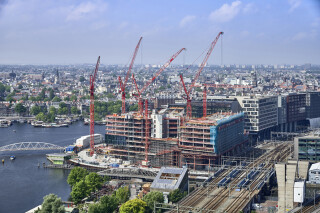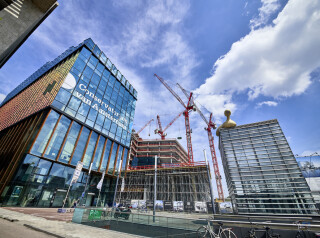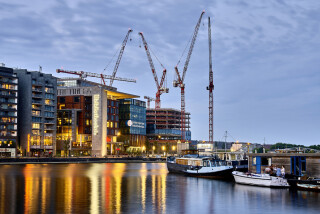Luffing jib tower cranes are a popular choice on congested sites where nearby obstacles – including neighbouring cranes – would limit the operation of a normal saddle-jib crane.
But at a site in central Amsterdam, where seven tower cranes are currently at work, even erecting the machines posed a logistical problem due to restricted access.
German contractor Züblin, a subsidiary of Strabag International, is building a new 11-storey office building – dubbed ODE – on Oosterdokseiland, an artificial island situated just to the east of Amsterdam’s central station.
The complex steel-framed building requires no fewer than seven tower cranes, five of them luffing models supplied by German manufacturer Wolff.
This article was first published in the Jul/Aug 2020 issue of The Construction Index magazine. Sign up online.

From this location, the mobile crane could erect only one of the seven Wolff tower cranes, a 50-tonne capacity 700B luffing crane. This was done at a radius of 28m.
Once erected, the tower crane was used to erect a second 700B – which in turn erected three Wolff 355B luffing cranes, each with a maximum lifting capacity of 28 tonnes.
These cranes were subsequently used to erect two small saddle-jib cranes, a 12-tonne 7032.12 ‘clear’ and a six-tonne-capacity 5014 City crane. Most of the cranes were configured with a maximum jib radius of 50m, except one of the 700B luffers, which can reach out to 55m, and the City crane which has a maximum radius of 30m.

Special anchors, designed to accommodate the building’s own foundations, were used to fix the cranes in place.

All cranes are also fitted with a camera system enabling the operator to monitor the load on a screen inside the cab.
High wind speeds are prevalent on Oosterdokseiland and so to withstand the lateral loadings, the cranes are erected on large-section towers: the two 700B luffers have 3.3m-square lattice towers while the three 355B crane are on 2.9m towers, allowing them to work free-standing in stormy weather.
Compared with a fixed horizontal saddle jib, the luffing jib design enables very small slewing radii, making this type of crane ideal for use in cramped site conditions. Despite their close proximity, the cranes can operate safely on this site without getting in each other’s way.
The 700B is a powerful crane, and its 50-tonne lifting capacity is being thoroughly utilised on this project. Steel columns weighing up to 28 tonnes and precast elements of up to 15 tonnes require the cranes’ maximum load-moment capacity at the necessary radii.
Some of the project’s steel beams weigh up to 35 tonnes and Wolff has designed special tandem lifts, to be carried out by the 700B machines, to handle these loads.

Got a story? Email news@theconstructionindex.co.uk


